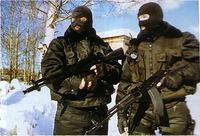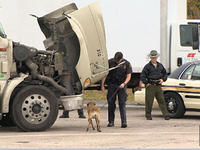-
Airships offer a solution for aviation’s future challenges
It is forecast that by 2020 the number of aircraft passengers will reach 400 million. The movement of freight by air is expected to increase by more than 340 percent over the next twenty years. During the same period congestion at many airports will squeeze out cargo operations because of economic and environmental reasons. Consequently, if market demand for air freight is to be met, either there will have to be significant investment in new airport infrastructure or alternative transport forms need to be considered. Researchers have completed a three year investigation into stratospheric passenger airships as part of a multi-national engineering project designed to provide a future sustainable air transport network. The researchers believe that airships offer a solution for future air transportation that is safe, efficient, cheap, and environmentally friendly.
-
-
Traceable fingerprints for freight items
Security is a top priority in air freight logistics, but screening procedures can be time consuming and costly. Researchers intend to boost efficiency with a new approach to digital logistics, without sacrificing the security of air freight operations. The researchers are working, among other things, on a marker that can be used to verify whether a freight item has already been X-rayed — something that has not been traceable. The researchers are additionally developing an RFID seal in order to detect subsequent tampering with a shipment.
-
-
U.S. to impose stricter safety rules on crude oil rail shipment
The U.S. Department of Transportation(DOT) recently announced proposed rulesbetter to secure train cars and pipelines from oil spills that may lead to fire or accidents in communities across the country. The spills are byproducts of the increase in U.S. oil production and shipments coming from Canada or the Bakken oil fields of North Dakota. The proposed DOT rules would force railroads to upgrade railroad cars used for transporting crude oil, employ better braking systems, and enforce tighter speed controls.
-
-
New rules proposed for crude oil shipments
U.S Department of Transportation (DOT) secretary Anthony Foxx has announced that the department is proposing new rules for shipments of high-hazard crude oil by trains, as well as moving to phase out the use of older tank cars that many see as unsafe. The order follows a deadly year for oil train accidents, including a July 2013 derailment in Lac Megantic, Quebec resulting in the deaths of forty-seven people and a 30 April derailment in Lynchburg, Virginia.
-
-
100% scanning of U.S.-bound cargo containers delayed until 2016
DHS has delayed until 2016 the implementation of key sections of the SAFE Port Act of 2006, which requires that 100 percent of U.S.-bound ocean containers be scanned at the foreign port of origin. U.S. importers welcome the news of the delay, but they urge Congress to eliminate the scanning requirement altogether. Some observers note that the mandate, in any event, fails to make clear how DHS defines the word “scanned.”
-
-
U.K. forwarders “not surprised” by U.S. climb-down on 100 percent container scanning
One leader of the international freight industry says it was “hardly surprising” to hear the recent news that the United States has delayed new rules requiring all cargo containers entering the United States to be security scanned prior to departure from overseas for two more years, amid questions over whether this is the best way to protect U.S. ports.
-
-
Bolstering shipping security
During a press conference following the March 2014 Nuclear Security Summit in the Hague, President Barack Obama noted that his biggest security concern was not Russia — or any other regional superpower — but rather “the prospect of a nuclear weapon going off in Manhattan.” Experts say that the most likely way in which a nuclear weapon would potentially come to a major U.S. city is not on the tip of a missile but in the belly of a ship, noting that this view has been openly validated by the intelligence community. In 2007, Congress passed a law requiring all overseas cargo containers to be inspected before they are loaded on a U.S.-bound ship. That law, however, has never been enforced.
-
-
U.S. takes action against tank car loaders for mislabeling hazardous cargo
One of the charges against Montreal Maine & Atlantic Railway (MMAR), the rail carrier operating the train which exploded in the small city of Lac- Mégantic, Quebec in July 2013, was that it mislabeled the cargo, claiming it to be less hazardous than it was. The mislabeling and downgrading of the contents of the cars allowed to company to take less rigorous security measures to secure the cars without appearing to break the law. The U.S. Department of Transportation (DOT) is moving against other carriers who mislabel the contents of their cargo to avoid the cost of required security measures.
-
-
Highly portable X-ray imaging system developed
Los Alamos National Laboratory and Tribogenics have developed the MiniMAX (Miniature, Mobile, Agile, X-ray) camera to provide real-time inspection of sealed containers and facilities.MiniMAX is an alternative to the large, expensive, and fixed facilities presently required for security inspections using X-ray imaging. The complete MiniMAX portable radiography system weighs less than five pounds.
-
-
Chechen Islamic terrorists threaten February 2014 Winter Olympics in Sochi, Russia

Doku Umarov, a leading Chechen Islamic rebel, on Wednesday issued a call to Islamist militants throughout the North Caucasus to begin and plan for attacks to disrupt the February 2014 Winter Olympics which will be held in the Black Sea resort of Sochi. Security experts say that securing the games would be a daunting task.
-
-
NY-NJ Port Authority centralizes security operations
The Port of Authority of New York and new Jersey has created a stand-alone Security Department and is now searching for a Chief Security Officer to oversee all security and safety functions, resources, and personnel
-
-
New cargo screening unveiled
Smiths Detection’s new HCVMe uses the power of a 4MeV X-ray accelerator and can scan loaded cargo containers with a steel penetration of 200 mm
-
-
Cargo security: there is a difference between “tracking” and “chain of custody”
For cargo to be under a tight chain of custody, it requires security throughout its carriage from stuffing, verification, and sealing at point of origin, confirmed by an authorized agent who arms a container’s security system and seals the container. All elements of cargo information, container identification in which it was sealed, identify of person verifying cargo, and all who had access to the cargo during movement and relating dates and times must be maintained electronically in the control system of the secure servers of the container security device provider.
-
-
TSA deploys vehicle inspection teams in Tennessee

Last week in an effort to improve security on U.S. highways, the Transportation Security Administration (TSA) established checkpoints at truck weight stations in Tennessee; working with the Tennessee Department of Homeland Security, TSA deployed Visible Intermodal Prevention and Response (VIPR) teams across the state to inspect vehicles
-
-
BSI will develop new system for screening cargo
DHS Science and Technology Directorate (S&T) has awarded a contract to BSI Group’s Supply Chain Solutions business unit for the creation of a protocol to aid the screening of cargo at U.S. ports
-
- All
- Regional
- Water
- Biometrics
- Borders/Immig
- Business
- Cybersecurity
- Detection
- Disasters
- Government
- Infrastructure
- International
- Public health
- Public Safety
- Communication interoperabillity
- Emergency services
- Emergency medical services
- Fire
- First response
- IEDs
- Law Enforcement
- Law Enforcement Technology
- Military technology
- Nonlethal weapons
- Nuclear weapons
- Personal protection equipment
- Police
- Notification /alert systems
- Situational awareness
- Weapons systems
- Sci-Tech
- Sector Reports
- Surveillance
- Transportation
Advertising & Marketing: advertise@newswirepubs.com
Editorial: editor@newswirepubs.com
General: info@newswirepubs.com
2010-2011 © News Wire Publications, LLC News Wire Publications, LLC
220 Old Country Road | Suite 200 | Mineola | New York | 11501
Permissions and Policies
Editorial: editor@newswirepubs.com
General: info@newswirepubs.com
2010-2011 © News Wire Publications, LLC News Wire Publications, LLC
220 Old Country Road | Suite 200 | Mineola | New York | 11501
Permissions and Policies
